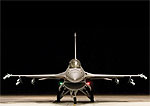April 17, 2013 Military Aviation News

04/17/2013
The advent of unmanned aerial vehicles taking flight within U.S. national airspace could mean an enormous economic windfall for aviation entrepreneurs and the nation’s economy.
But a booming domestic UAV industry is desperately trying to break free of strict rules that will keep their designs grounded until 2015 at the earliest. UAV advocates are finding their message difficult to deliver, with widespread assumptions that lethal war machines will buzz their neighborhoods.
(Read More...)

04/17/2013
In its latest account of national defense efforts, China said Tuesday that the United States is destabilizing the Asia-Pacific region by strengthening its military alliances and sending more ships, planes, and troops to the area. The U.S. policy known as the "pivot" to Asia runs counter to regional trends and "frequently makes the situation tenser," the Defense Ministry said in its report on the state of China's defense posture and armed forces.
(Read More...)

04/17/2013
A senior executive at U.S. defense company Raytheon has ruled out the possibility of a U.S. governmental or congressional blockade against the delivery of a critical air defense and anti-missile system, dubbed as T-LORAMIDS, if Turkey chose the Patriot solution in multi-billion dollar international bidding.
(Read More...)

04/17/2013
The Russian aircraft manufacturer MIG said it plans to continue its decades-long cooperation with India in developing and building MiG aircraft. “The MIG corporation wants to broaden cooperation with India's public, military and research organisations,” MIG General Director Sergei Korotkov said in remarks read out from a statement at the Indian Embassy in Moscow.
(Read More...)

04/17/2013
Upcoming shore-based and carrier tests will help the Navy determine its acquisition strategy for the Unmanned Combat Air System (UCAS), a large, carrier-based, next-generation drone with a 62-foot wingspan and high-tech sensors engineered to gather and send back images and data, service officials said. “The UCAS will be the first deployed carrier based unmanned air vehicle with persistent ISR and a strike capability,” said Navy spokeswoman Jamie Cosgrove.
(Read More...)

04/17/2013
The Naval Institute of Aeronautical Technology (NIAT), a premier training establishment under the Southern Naval Command, is forging alliance with what it terms as ‘six indigenous elements’ as part of its ‘train the trainers’ programme to keep its instructors abreast of emerging aviation technologies and practices.
(Read More...)

04/17/2013
The Gripen NG has much less capability than the F-35, because it is not stealth and never will be. Its range is much smaller, especially in AG configuration. The only advantage of the Gripen NG may be a lower procurement cost, but this is also very uncertain, because so far nobody has ordered the Gripen NG. The future of Gripen NG is not established. Just for comparison, the manufacturing of the 100th F-35 has been started.
(Read More...)

04/17/2013
Delays in the development and fielding of the F-35 Joint Strike Fighter have underscored the need for the U.S. military and its allies to keep current jets technologically relevant. It has not been decided whether the U.S. Air Force will outfit about 300 F-16s with Northrop Grumman’s Scalable Agile Beam Radar (SABR) or Raytheon’s Advanced Combat Radar (RACR). Both are capability upgrades from existing systems that give pilots much greater image resolution and target recognition.
(Read More...)

04/17/2013
The Air Force plans to upgrade all 1,018 of its F-16s and 175 F-15C/D Eagles to keep them flying until the F-35A joint strike fighter is fully operational and new weapons systems on the F-22 Raptor are installed, according to the 2014 budget request released April 10. In the fiscal 2014 budget request, the Air Force states the service life extension for all F-16s will add eight to 10 years to each airframe.
(Read More...)

04/17/2013
Just days before President Obama released his fiscal year (FY) 2014 budget request, the Air Force reported that it will have to ground one-third of its aircraft due to budget constraints.
Operations and maintenance accounts will be hit particularly hard, causing the Air Force to severely restrict which of its assets will continue to operate. With U.S. military readiness already suffering from years of budget cuts, and many more years of insufficient modernization and recapitalization to come.
(Read More...)
All Articles